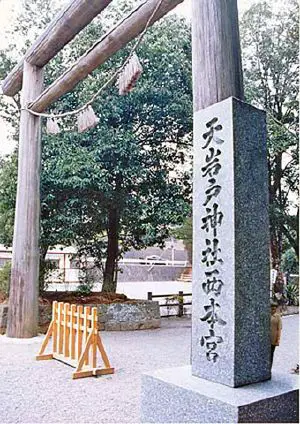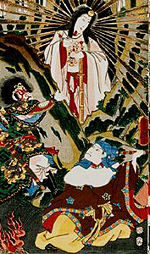Amaterasu
- For other uses, see Amaterasu (disambiguation).
Amaterasu (天照), Amaterasu-ōmikami (天照大神 or 天照大御神) or Ōhiru-menomuchi-no-kami (大日孁貴神) is in Japanese mythology a sun goddess and perhaps the most important Shinto deity (神 kami). Her name, Amaterasu, means literally "(that which) illuminates Heaven." She was born from the left eye of Izanagi as he purified himself in a river and went on to become the ruler of the Higher Celestial Plane (Takamagahara) and was also considered to be directly linked in lineage to the Imperial Household of Japan and the Emperor, who were considered descendants of the kami themselves.
History
Story of Amaterasu
Amaterasu is described in the Kojiki as the sun goddess who was born from Izanagi, who was also accompanied by her sibling, Susanoo, the storm deity. In the Kojiki, Amaterasu is described as the goddess from which all light emanates and is often referred to as the sun goddess because of her warmth and compassion for the people who worshipped her: an interpretation of "light" or "heat" as passion, or purity. This is thought of as a likely interpretation, as upon seeing the actions of her brother, Susano'o, she fled to the cave, Ama-no-Iwato in embarrassment, obscuring the light she emanated and plunging the world into darkness.
Despite the fact that several interpretations list Amaterasu as acting in embarrassment, several places cite her acting out of fear of reprisals from her brother. According to one interpretation[1], Amaterasu, when visited by her brother, was fearful because of her brother's use of power; using lightning and storms to manipulate the earth so as to allow him easier passage to meet her on the plane of high heaven (高天原, Takamagahara), which subsequently caused all living beings to go into hiding.
Upon seeing the use of Susano'o's power, Amaterasu took precautions and readied a bow and quiver at her side. Despite the fact that this may be seen as a somewhat rash decision, before meeting Amaterasu, Susano'o was persistent in meeting his late mother in the underworld. However, it is detailed that Susano'o feared becoming lost, as he had learned of the disturbing nature of the underworld. So it is possible that Amaterasu feared Susano'o had visited the underworld and returned somewhat jaded or changed.
The other gods begged her to come out, to no avail. Then the goddess Ama-no-Uzume had an idea. She hung a mirror (鏡 kagami) on a nearby tree, organized a celebration, and performed an erotic dance before the cave. It made the other gods laugh so loud that Amaterasu became curious and peeked out. She saw her own reflection in the mirror, which startled her so much that the other gods were able to pull her out and convince her to return to the sky.
Later she sent her grandson Ninigi-no-Mikoto to pacify Japan: His great-grandson became the first emperor, Emperor Jimmu. He had a sacred sword (Kusanagi), jewel (Yasakani no magatama), and mirror (Yata no kagami) that became the Japanese imperial regalia.
Amaterasu is credited with inventing the cultivation of rice and wheat, the use of silkworms, and weaving with a loom.
Her most important shrine, the Grand Shrine of Ise, is in Ise in western Honshū. The shrine is torn down and rebuilt every 20 years. In that shrine she is represented as a mirror, one of the three Japanese imperial regalia. The Ise Shrine is said to be the home of Amaterasu. This shrine, however, is not open to the public.
She is celebrated every July 17 with street processions all over the country. Festivities on December 21, the winter solstice, celebrate her coming out of the cave.
Until forced to recant (in the terms of surrender at the end of World War II), the Japanese royal family claimed descent from Amaterasu, and the emperor was officially considered divine.
Difference in Kojiki and Nihonshoki
In Kojiki and Nihonshoki, the goddess was described with slight difference. Mainly, the story of Kojiki is much better known.
First is the story of her birth. In Kojiki she was born after Izanagi failed to retrieve Izanami from underworld. However, in Nihonshoki, Izanagi and Izanami, who was still alive, together decided to create the supreme deity to reign over the world, and gave birth to Amaterasu.
Episode of sending her grandson to Awara-Nakatsukuni (Japan) is also different in two myths. In Kojiki, Amaterasu commanded her son and other gods to pacify Japan. On the other hand, the main article of Nihonshoki records the myth that it was Takamimusubi-no-Kami who took control of the event and sent his maternal grandson Ninigi to Japan. The role of Amaterasu is ambiguous in the episode.
In both cases, Nihonshoki records similar version of Kojiki episode as "aru-fumi", the alternative episode.
Amaterasu in popular culture
- Amaterasu appeared as a character in the 2003 film Onmyoji II, played by Kyōko Fukada.
- In the video game Ōkami, the main character is Amaterasu incarnated as a wolf, and is constantly referred to as "origin of all that is good and mother to us all." She uses the Reflector, Glaive, and Rosary as weapons in the game.
- A character in Tad Williams' Memory, Sorrow, and Thorn series is named Amerasu after her.
- Amaterasu (played by Kira Clavell) features as a character in the Stargate SG-1 television series. In the show, she is an ancient Goa'uld responsible for seeding the Shinto religion on earth thousands of years ago.
- Itachi Uchiha in the popular anime/manga Naruto has a technique by the name of Amaterasu.
- Amaterasu was the name of the main flagship in the anime Starship Operators.
- Amaterasu was also the name of the Asuka City counterpart in Digimon World 3
- Amaterasu is a character in the manga Tsubasa: Reservoir Chronicle, in which she is the older sister of Princess Tomoyo (also known as Tsukuyomi) and the Empress of the Nihon/Japan (the world Kurogane came from). She is recognized as Tsubasa's incarnation of RG Veda's Kendappa-ō.
- In the Sailor Moon R series, episode 53 "Mamoru and Usagi's Babysitter Mayhem", the monster of the day is 'Amaterasu', based on the sun tarot card as well as the shinto religion.
- In the manga Five Star Stories by Mamoru Nagano, Amaterasu is the name of one of the central characters. He is the God of Light, and the emperor of the kingdom of Grees on the planet Delta Belun. (In the context of the story, 'Amaterasu' is the family name of the members of the imperial family.)
- In the RPG Shin Megami Tensei: Nocturne, Amaterasu is a playable character.
- In NetHack Amaterasu Omikami is the lawful Samurai deity.
- In Dream Saga Amaterasu is to be consumed by the nature's dragon Susanoo in order to wipe out humanity and let the world be reborn.
- In Naval Ops : Commander, Amaterasu is the name of one of the strongest enemy superships, and the strongest drillship in the game.
See also
- Japanese mythology
- Himiko
|
Mythic texts and folktales:
| |
| Religions | Sacred objects | Creatures and spirits |
Credits
New World Encyclopedia writers and editors rewrote and completed the Wikipedia article in accordance with New World Encyclopedia standards. This article abides by terms of the Creative Commons CC-by-sa 3.0 License (CC-by-sa), which may be used and disseminated with proper attribution. Credit is due under the terms of this license that can reference both the New World Encyclopedia contributors and the selfless volunteer contributors of the Wikimedia Foundation. To cite this article click here for a list of acceptable citing formats.The history of earlier contributions by wikipedians is accessible to researchers here:
The history of this article since it was imported to New World Encyclopedia:
Note: Some restrictions may apply to use of individual images which are separately licensed.

